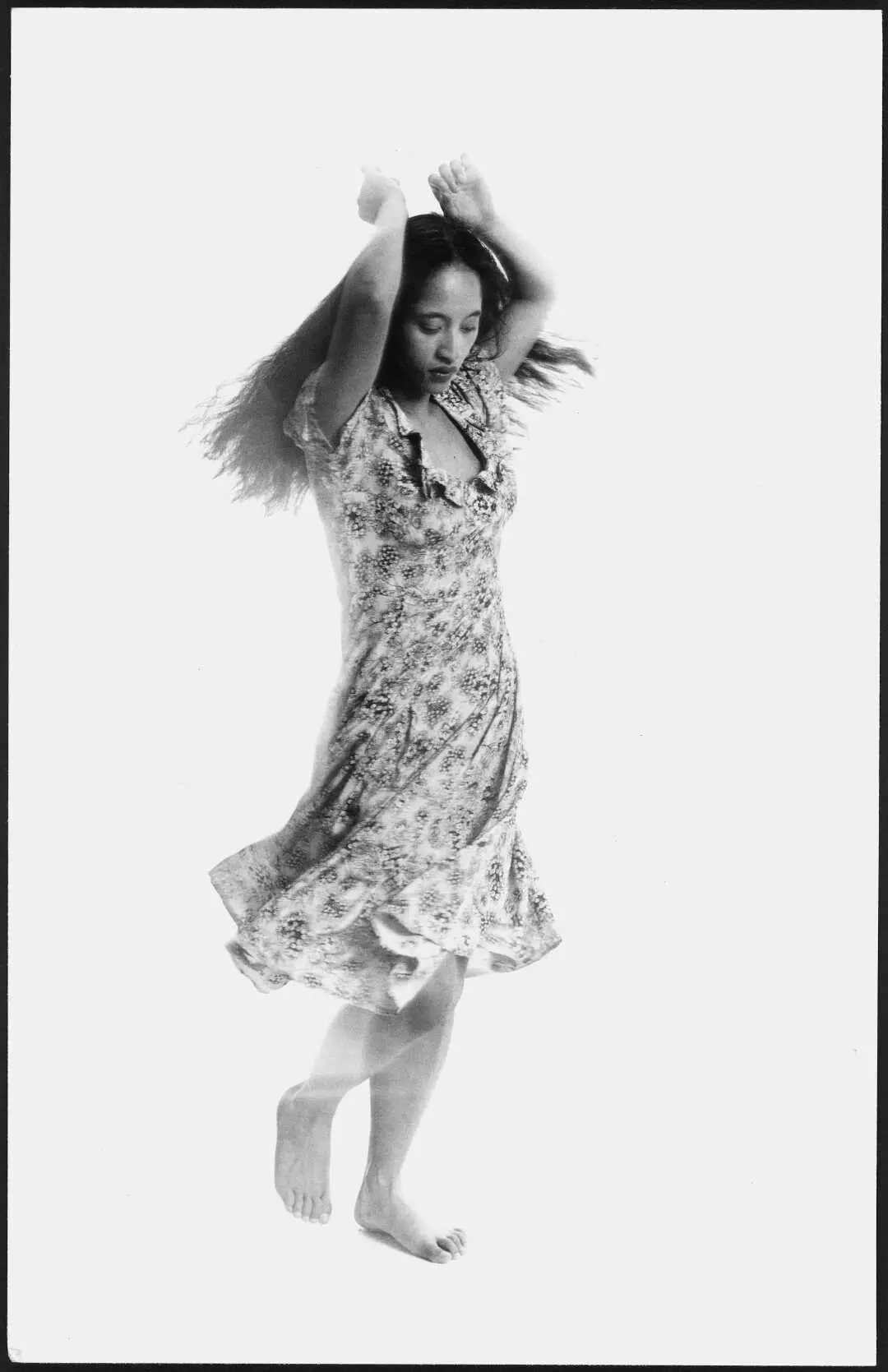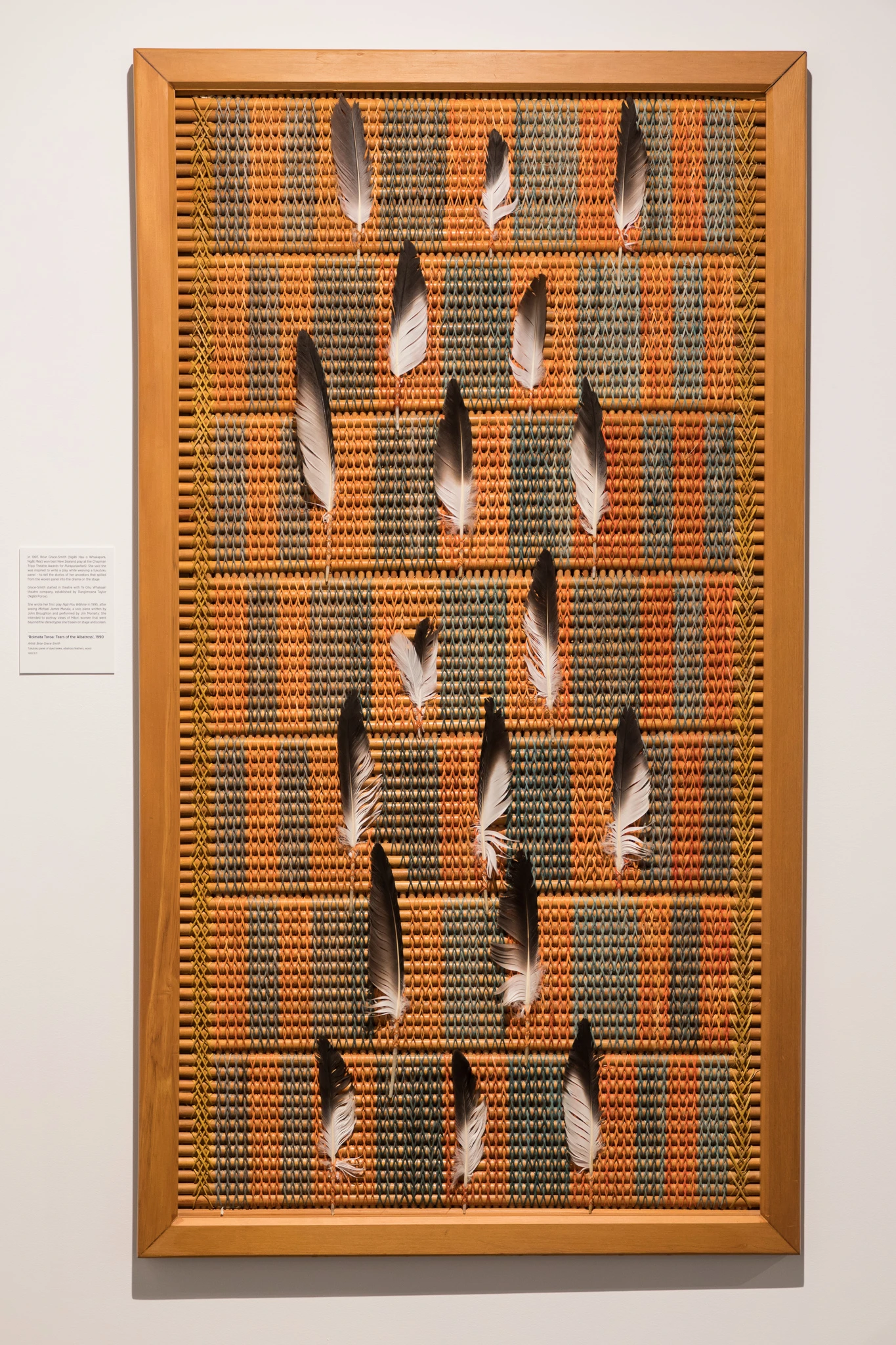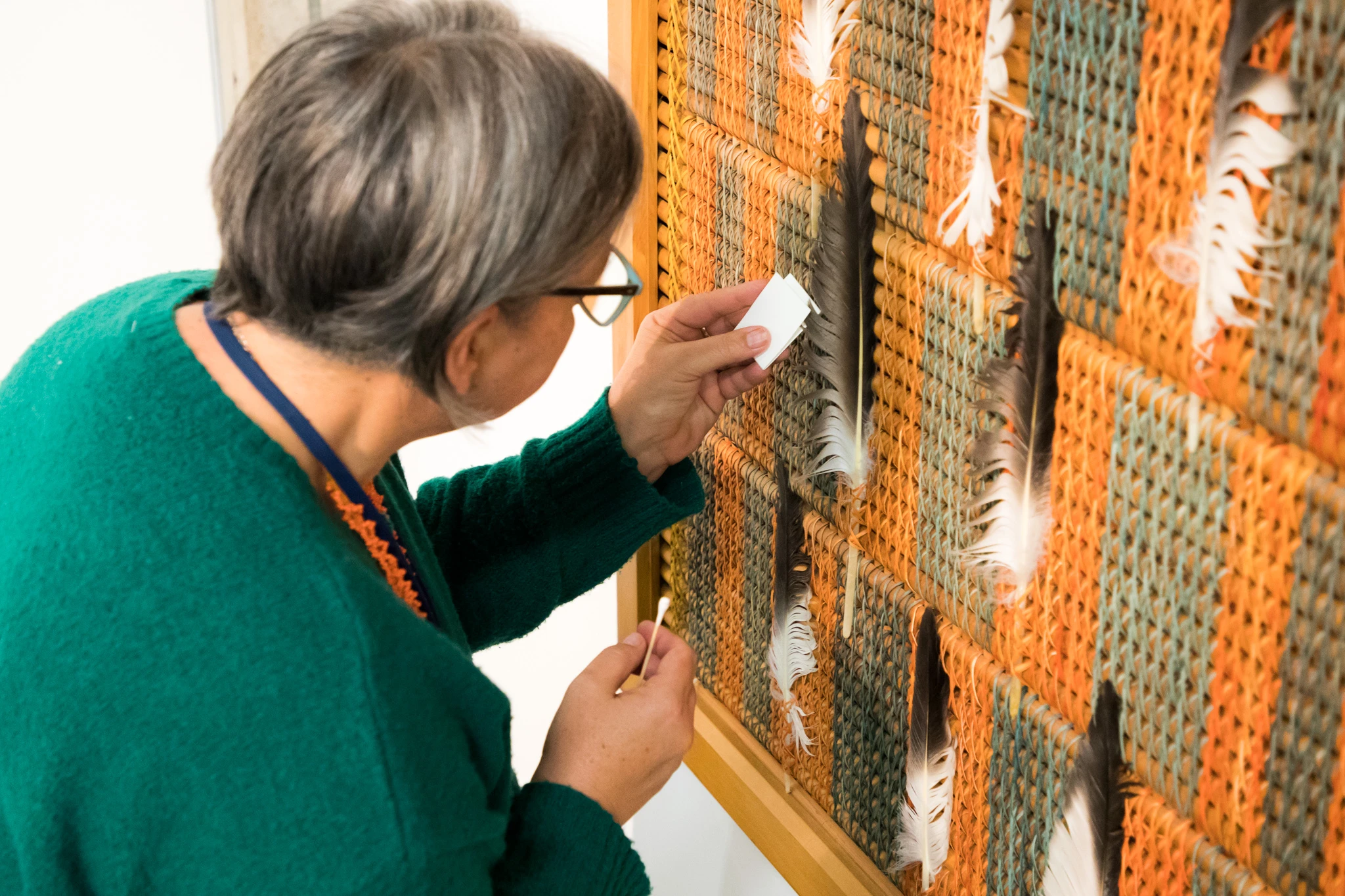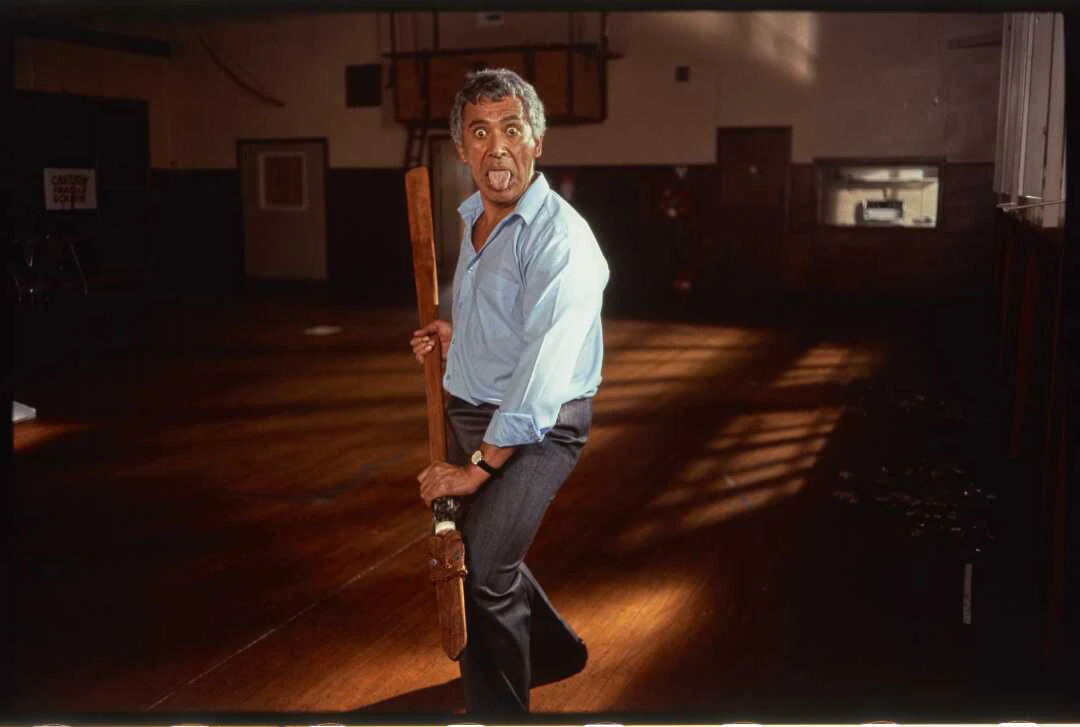
Making our voices heard
The marae ātea is the Māori stage and the drama of whatever was happening at the marae was played out there — Te Haumihiata Mason
Take an audio tour with Paul Diamond one of the curators of Pūkana. Paul shares stories and highlights from the exhibition.
Listen to Paul Diamond talk about ‘Making our voices heard’ in Pūkana
Transcript — Making our voices heard
Then the next part of the exhibition is called Ngā Pou Wāhine. And it's kind of acknowledging that, yes, there was a revival happening, but sometimes performance has happened in a context of protest and pushing up against norms. And Vicki-Anne Heikell as part of her curation of Pūkana identified two beautiful photographs here in the exhibition are placed side by side. One is of Nancy Brunning, the actor, as part of the Downstage Theatre production of ‘Waiora’. So, Downstage Theatre have deposited their collection with the Turnbull Library.
So Nancy's sort of – it captures Nancy mid-movement. She’s sort of, twirling around. Her dress is, sort of, moving – it’s in motion and her hair’s in motion – and her arms are up.
It's a beautiful image, kind of, a bit like the image in a different section of Pūkana which captures women doing poi and their piu piu moving as they're doing that. Beside this image of Nancy Brunning is an image of Tuaiwa or Eva Rickard and she's dancing at Moutoa Gardens, which was occupied in 1995. So Māori occupied Moutoa Gardens in protest about that land – what had happened to that land.
And we, kind of, like – we've put these two images together to sort of acknowledge that there is theatre in protest, and then also protest came into theatre. Because what happened in Māori theatre is that the grievances, the take, the kaupapa, of the protest movement came into the theatre. And when you started to go to Māori theatre from sort of the 80s, 90s at least as early as that, there were things like powhiri and haka and waiata, which hadn't really happened before in theatre. So that's what we're doing in these two images that we're setting up the sort of foundational ideas of the section.
‘Ngā Pou Wāhine’ is the name of a play by Briar Grace-Smith, who's been a key figure in Māori theatre, the revival of Māori theatre. And at the National Library, we have some tukutuku panels. And some of them were actually made by Briar Grace-Smith. So there's the chance to see one of these here, and it's called Roimata Toroa or Tears of the Albatross. So it's a tukutuku panel, but it's also got feathers on it as well.
So it's wonderful to be able to see this, because this has been in storage for many years and not many people have had a chance to see it.
Then in this exhibition, which is looking at the connection between performance and protest, we've got material to do with Herbs and reggae and acknowledging the connections between people like Bob Marley when he came to New Zealand and then groups that were inspired by him like Dread Beat and Blood. And this is a photo of David Grace, a photo of a – sorry, a copy of a poster – for when Herbs, the group Aotearoa, and Dread Beat and Blood all performed at Victoria University.
And then we're also looking at ‘Once Were Warriors’, because we're conscious that it's the anniversary of that film coming out and Communicado Features deposited the production archive of that film with the Turnbull Library. So there's a photo in this section of Rena Owen who was one of the actors in the film with Riwia Brown, who wrote the screenplay based on Alan Duff's book. So we've also got, for example, an image in this Pūkana section, the image of George Henare doing pūkana is from when George Henare played the social worker in that film. So you've, sort of, got these references threaded through the exhibition.
The last part of this performance and protest section Ngā Pou Wāhine is devoted to Carmen, who we thought really lived her life in a way that could be seen as an act of protest. Because it took a lot of courage to live your life like she did at that time and that she created a space for other performers like Mika. So we've got a poster for this production that was on in 1994 during the Hero Festival in Auckland, and it was Carmen and Mika performing together. It was called ‘Carmen's International Coffee Lounge’.
And in the case, we've got a photo album. Carmen deposited her collection with us and with Te Papa and we have this fantastic collection of photos. But it's even more fantastic, because Carmen went through and wrote on the back of the photos. She also wrote in the album. So there's a lot of really valuable information in this album, and the whole album has been digitised because we were conscious that it's not easy for people to see it once it's in the exhibition for eight months. So that's available online.
And in the case with that album — photo album — we've got a book and a poem by one of the really exciting poets and artists at the moment, a woman called Tayi Tibble and her poem ‘Identity politics’ from 2018. And that comes from her book, ‘Poūkahangatus’, which has a stunning cover which is in the case. And when Vicki-Anne pointed this out to me, she said, you know although you can see that things kind of have changed a lot from those early, sort of, activists and protesters. When you read Tayi’s poem, which is available online, you can see that some of the ideas really haven't changed even among the young people coming through.
In the exhibition, we have a few slideshows. And one of them is of our colleague Dylan Owen, who works in the Services to Schools section, photos he's taken, because Dylan also has a career as a photographer. And Dylan has documented protests and events, mostly in Wellington, but also in other bits of the country, since 2002. And he has donated his collection over time to the Library as well.
So we've got a selection of some of Dylan's images of performance, sometimes in the context of protests, but also other contexts as well. So things like the anniversary of the Public Service Association and students from a Kura Kaupapa Māori, Te Kura Māori o Porirua, performing.
Any errors with the transcript, let us know and we will fix them: [digital-services@dia.govt.nz](digital.services@dia.govt.nz?subject=Transcript update&body=Please add the link to the page you are emailing us about.)
Ngā pou wāhine
E rangona tonutia ana ngā mamaetanga o te murunga whenua, te rironga o te reo me te āhua Māori i runga i ngā marae, i roto i te karanga, i te whaikōrero, i te waiata, i te atamira hoki.
Kei ngā whakamāoritanga a Wiremu Rurutao nā Pei Te Hurinui i tuhi, ka rangona ngā rerenga kōrero o te reo rangatira o te marae Māori.
Hei whakaata te ingoa o te rōpū whakaaro o Maranga Mai i tō rātou hiahia ki te whakaputa wero mō ngā take nunui. I muri i tā rātou whakakitenga tuatahi i te Whare Pāremata i 1980, ka puta tētahi tuhinga whakapae ki te Takawaenga Whanaungatanga ā-Iwi he whakapātaritari i te wairua kino tā rātou mahi.
Tekau mā rima tau i mua, kua puta te umere nui a te tangata mō ngā whakakitenga ātaahua o te kāhui kaiwhakaari Māori o Porgy and Bess, he mea ārahi nā Inia Te Wiata. I whai mai te Māori Theatre Trust, ko tāna he whakahihiri i ētahi atu tāngata Māori kia whakakitea ngā paki me ngā whakaari Māori.
I rongo ahau i tā rātou karanga, te reo ata pūao, ā ngā reo wāhine onamata e maranga ake ai i ngā oro wiri mai i te motu – Anahera Gildea (trans. Herewini Easton)
Making our voices heard
The ache of land confiscation and loss of language and identity continue to be voiced on the marae, in karanga, whaikōrero, waiata, and on the stage.
Pei Te Hurinui Jones’s translations of Shakespeare poetically echo the voices of the marae.
Maranga Mai theatre group’s name reflected their desire to challenge issues. Their performance at Parliament in 1980 drew an official complaint to the race relations conciliator alleging they incited racial disharmony.
Fifteen years earlier, the Māori cast of Porgy and Bess, led by Inia Te Wiata, received rave reviews for their performances. The Māori Theatre Trust that followed inspired other Māori to perform Māori works.
I heard their karanga, the dawn voice centuries of women rising up in a vocal wiri from the motu — Anahera Gildea
Nancy Brunning in the New Zealand International Festival of the Arts production of Waiora at Downstage Theatre, 1997. Photograph by Stephen A'Court Ref: PAColl-8784-65-1. Alexander Turnbull Library.

Roimata Toroa — Tears of the Albatross by Briar Grace-Smith.

Vicki-Anne Heikell doing some conservation work on the ‘Roimata Toroa — Tears of the Albatross’ panel.

Production still from film ‘Once Were Warriors’ showing character Bennett (George Henare) with a taiaha. He is performing a pūkana. Photograph taken by Kerry Brown or Ann Shelton in 1993. Ref: PA1-q-1172-40-5-RA64/21. Alexander Turnbull Library.

Related content

The ‘Māori strum’
See the Māori strum . . . jingajik a jingajik. That’s what they call it, ‘Do you know the jingajik, bro?’ – Jamie McCaskillFeature image at top of page: Part of the ‘Making our voices’ heard section of the Pūkana exhibition. . Photo by Mark Beatty.